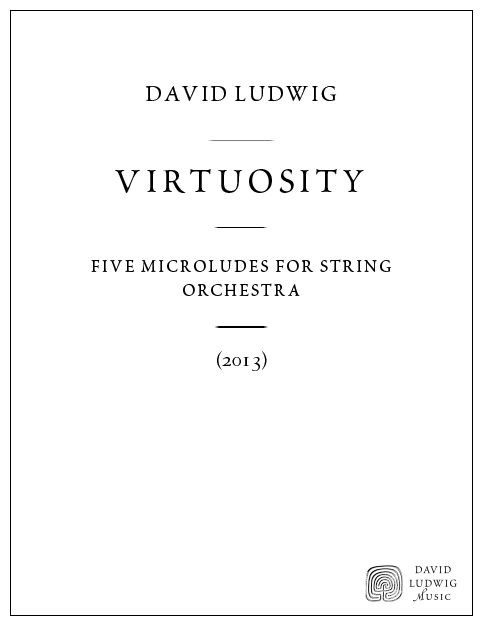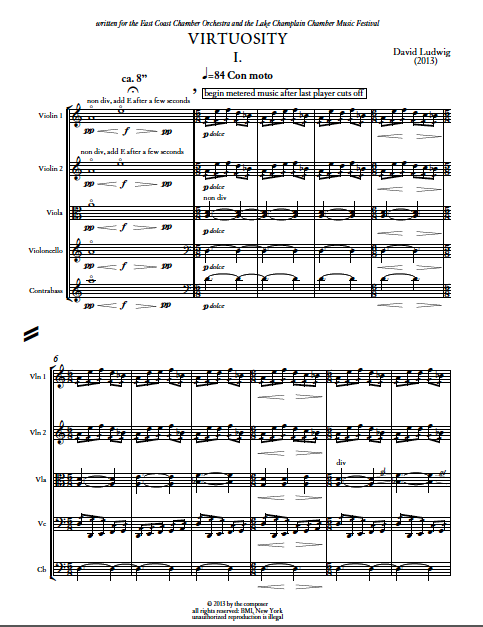

Virtuosity: Five Micro-concertos for String Orchestra
Virtuosity: Five Micro-Concertos for String Orchestra (2013), 24'
-String Orchestra
-Commissioned by ECCO
-Premiered at the Lake Champlain Chamber Music Festival August 2013
Rental information
Program Listing
Virtuosity - Five Microconcertos for String Orchestra (2013)
I. Concerto for Two Violins
II. Concerto for Viola
III. Concerto for Cello
IV. Concerto for Contrabass
V. Concerto for Orchestra
Program Notes
My confession: I am musically addicted the idea of making something new in my music out of something old and preexisting. I’m not alone, either–the practice of writing a new piece using the materials of an older work is almost as old as the act of composing, itself. I think of it like a sculptor might, if that artist could take the clay a great master used in a piece and reshape it into his or her own newly personal work. Fortunately music isn’t made out of immutable solids, but exists on a page in abstract as a set of instructions to the performer to recreate sounds and ideas.
The title of my string orchestra piece “Virtuosity” was inspired by the programmatic theme of the 2013 Lake Champlain Music Festival. This piece started with that title, as I was also thinking of the concept of virtuosity already as it related to the East Coast Chamber Orchestra, an extraordinary ensemble comprised of all-virtuoso players. I decided that the best way to explore the idea was to make a piece made of “micro-concertos,” so that I could express virtuosity in different ways with each string instrument.
The piece is built on the format of the Baroque Concertino, with parts for a core group of soloists surrounded by a larger ensemble. The first micro concerto is for two violins (like the Baroque trio), and follows with solo viola, cello, and contrabass, with some movements eliding into each other without pause. The final movement is a concerto for the whole orchestra, including a double fugue for the ensemble and then soloists in the middle of it (the fugue as a form is about a kind of compositional virtuosity that has challenged composers for hundreds of years).
And here is the spoiler alert: if you’d just like to experience the piece, I recommend you stop reading here or at least skip over the next paragraph…
OK, then (who skipped?). By many accounts, the first truly canonic virtuosic work is the famous Chaconne from Bach’s 2nd Violin Partita, and this is a piece that lives with all musicians, not just violinists. For me, it was the final ingredient to writing “Virtuosity;” an work familiar to everyone that I could use as the source for my piece—the old master’s clay from which I could sculpt my own work. The “Chaconne” is not just virtuosic in the fingers; it demands that the performer change expression, color, and approach constantly over the course of the long arc of the musical narrative. Everything in “Virtuosity” draws from this one epic movement by Bach that would define string playing forever after. And in some sense, this piece is a reverse variations, where the theme of whose many iterations you’ve been listening to all along–is revealed at the end.
“Virtuosity” was written for ECCO to be premiered at the Lake Champlain Chamber Music Festival, and was commissioned by seventy-nine individuals from our musical community through an Indiegogo campaign that the festival initiated and managed. For a composer to have this kind of support and connection from so many people is as meaningful as it gets, and–in the end–the reason we make music in the first place.
Press
...there are piquant moments. At one point, cellos and violas whisper underneath a soulful solo cello melody, and neo-Baroque unanimity near the end dissolves into clever snaps, slaps and slides under a stern double bass solo. And the orchestra, as always, played luminously. – New York Times
New music can sometimes leave listeners perplexed, but the two ECCO chose were not only terrific to hear but were exceptionally well conceived. David Ludwig’s “Virtuosity: Five Microconcertos for String Orchestra” (2013) spotlighted the skills of two violinists , a violist , a cellist and a double bassist. Each soloist leaped through technical hoops while the others supported with churning or darkly repeating motifs. The music moved between fast and slow sections, sometimes like a frenetic devil’s dance to a haunting lament, but always deeply lyrical with rich regal colors. Extended techniques such as the basses snapping their strings with loud thwacks, slow glissandos, or tapping the instrument rhythmically added aural texture. Both works were done superbly and the audience gave them standing ovations. – Schenectady Daily Gazette
There's a neo-Baroque opening movement showcasing two violins, mostly in their upper registers; an episode for solo viola that alternates brooding, lyrical lines with buzzing, quicksilver exchanges with the orchestra; a discursive section for solo cello; a concise "microconcerto" for double bass; and everything wraps up with a final fugue...one came away from this hearing most impressed by Ludwig's handling of the music's many transitional sections, which, in their usage of various extended techniques, seemed to draw on much more intriguing sound worlds and musical vocabularies... – Worcester Telegram
